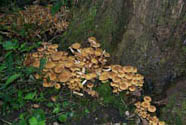 Key to Gilled Mushrooms Key
Key to Gilled Mushrooms KeyThis is a key to gilled mushrooms, that is, mushrooms having a definite cap with a fertile surface consisting of gills. The fruiting body usually also has a stem, although that may be lateral or absent (usually, then, the mushroom is growing from wood). You can use this key to identify mushrooms that you find.
 Agaricales Order
Agaricales OrderFruiting body containing fibers (usually in the stalk)
 White Spored Suborder
White Spored SuborderSpore print "light-colored": white or buff, sometimes tinged with pink or tan. Greenish and (except for the Russulales) yellow spore prints also go here
Stalk fibrous, not fracturing like a piece of chalk
 Tricholomataceae Family
Tricholomataceae FamilyNone of the special features distinguishing the other white-spored genera:
Gills not free, as in the Lepiotas and Amanitas
Basidia not extra-long, as in the Hygrophoraceae
Spores smooth, except for Lentinellus
 Lignicolous Trich Subfamily
Lignicolous Trich SubfamilyGrowing on trees or dead wood, leaves, or sticks, or organic debris, often in moss
 Normal LignoTrich Tribe
Normal LignoTrich TribeShaped like a “normal mushroom”
Small and fragile to medium-sized, except for one large, grey-capped species
Small Ligno Trich SubtribeFruiting body small: cap up to 1 1/4" across (and most clearly smaller than that)
Mycena Genus Persoon: S. F. Gray

Diagnosis
- Cap bell-shaped, conical, or either of those with an umbo; margin never incurved; usually some shade of grey or brown, but purplish in one unusually large species.
-
Stem thin; either very fragile or very tough
-
Some species have a colored juice that can be squeezed out of the end of the stem
-
No rhizomorphs
Narrow down your identification:
 Bleeding Mycena Subgenus
Bleeding Mycena Subgenus- Cap and stem exuding a yellowish, orange, or red latex if cut and squeezed
 Brownish Mycena Subgenus
Brownish Mycena Subgenus- Cap some shade(s) of brown, grey, black and white, with no other colors
 Colorful Mycena Subgenus
Colorful Mycena Subgenus- Cap, stem or gills with some colors (orange, yellow, pinkish or purple, for example) other than brown, grey, black and white






 Key to Gilled Mushrooms Key
Key to Gilled Mushrooms Key Agaricales Order
Agaricales Order White Spored Suborder
White Spored Suborder Tricholomataceae Family
Tricholomataceae Family Lignicolous Trich Subfamily
Lignicolous Trich Subfamily Normal LignoTrich Tribe
Normal LignoTrich Tribe




